
The Louis L'Amour Lost Treasures Project
|
|||
|---|---|---|---|
The Equipment of the Cow-Hand
|
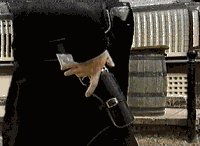 The "Slip-Shot" |
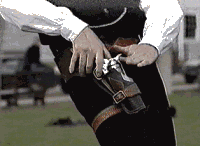 "Fanning" the gun |
Most of the gunfighters and gunman were what was known as "slip-shots", firing the single-action pistol by letting the hammer slide under the thumb. The gun was cocked during the draw and the gun fired by simply letting go the hammer. It was the fastest, the easiest, and the method used by most of the top gunfighters.
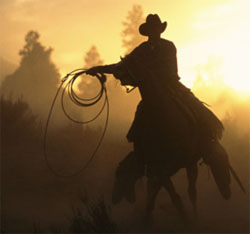 The rope, also called a lasso, riata, or lariat was an
item that varied considerably according to the part of the country in which it was used. The Texas boys rarely used a rope more than sixty-five feet long, and the average might be as short as forty-five feet. On the other hand, the vaqueros of early California, perhaps the greatest ropers of them all, used ropes of eighty-five feet and a few have been measured at over a hundred feet. It took quite a hand to use those long ropes, and they are now largely of the past.
The rope, also called a lasso, riata, or lariat was an
item that varied considerably according to the part of the country in which it was used. The Texas boys rarely used a rope more than sixty-five feet long, and the average might be as short as forty-five feet. On the other hand, the vaqueros of early California, perhaps the greatest ropers of them all, used ropes of eighty-five feet and a few have been measured at over a hundred feet. It took quite a hand to use those long ropes, and they are now largely of the past.
Incidentally, there is nothing that moved in the west that some cowboy hasn't tried to rope. Many have roped bears even the grizzly, not a few have roped mountain lions, even eagles, buzzards, and in at least one case, a prairie dog. There have been a half dozen cases where drunken cowhands have roped the stack of a locomotive, always with disastrous results, of course.
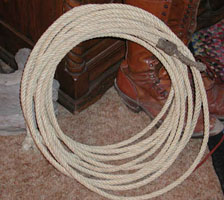
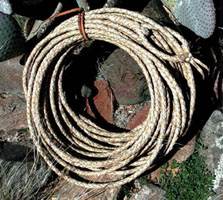
The rope was sometimes of hair or manila, much more often, in those early years, of plaited rawhide. The dexterity of a good hand with a rope would enable him to make his catch of either fore or hind feet or any place that happened to be necessary or the result of impulse.
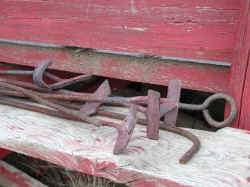 In the early years the cowhand carried a running iron
for branding. Later, this became strictly illegal, at least by cow country law, which meant the law of pistol and rope. The running iron could be used to make any brand, and so was convenient for the rustler. As such it could be a one way ticket to a hanging, so the rustler devised other means. A cinch ring, held with two sticks, could do the job just as well, or some twisted wire. A book could be written on methods or tricks of branding illegally.
In the early years the cowhand carried a running iron
for branding. Later, this became strictly illegal, at least by cow country law, which meant the law of pistol and rope. The running iron could be used to make any brand, and so was convenient for the rustler. As such it could be a one way ticket to a hanging, so the rustler devised other means. A cinch ring, held with two sticks, could do the job just as well, or some twisted wire. A book could be written on methods or tricks of branding illegally.
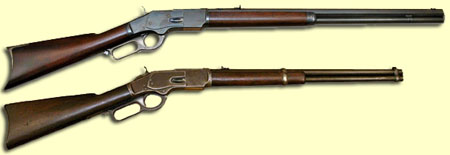
The Winchester, usually a '73 or '76, was the saddle gun of choice, although in the earlier years it was the .44 Henry or the .56 Spencer. Occasionally, the old Sharps buffalo gun was found, and this was almost always the .50 calibre, although it was made in other sizes to a limited degree. The .50 was most often used with a 473 grain bullet and 90 grain of powder, although nearly all buffalo hunters loaded their own and the loads varied considerably.
 Few working cowhands had the money to buy elaborate
outfits or to go in for much decoration, and in the early days on the cattle trails, silver conchas and such decorations reflected sunlight from too great a distance and were an invitation to any Indian who considered himself a marksmen. The same went for a white horse. He could be seen from too great a distance.
Few working cowhands had the money to buy elaborate
outfits or to go in for much decoration, and in the early days on the cattle trails, silver conchas and such decorations reflected sunlight from too great a distance and were an invitation to any Indian who considered himself a marksmen. The same went for a white horse. He could be seen from too great a distance.
However, there were dude cowpunchers who would even make the elaborate outfits of Roy Rogers pale by comparison. One of these was the gunfighter, outlaw, deputy sheriff, King Fisher. He once had his gang hold up a circus and kill the tiger so he could have some tiger-skin chaps!
He was 5' 9" tall, 135 pounds with light hair and brown eyes. A photograph of King shows that he was good looking and wore a large mustache. He was an imposing figure, once described by Texas Ranger N. A. Jennings as wearing an ornamented Mexican sombrero, a black Mexican jacket embroidered with gold, a crimson sash, and boots, with two silver-plated, ivory-handled revolvers swinging from his belt. Of course, he wore his tiger skin chaps and silver spurs mounted with silver bells that announced to everyone within earshot the presence of King Fisher. His full name was John King Fisher and he was called King by the family from the time he was a child. Some have reported that he adopted the name to reflect his flashy dress but this is not the case. John King Fisher, the terror from Eagle Pass, was buried on his ranch clad in his famous chaps and other of his flashy regalia. He was thirty years old. In the 1930s, his body was moved from its original burial site and buried in the Pioneer Cemetery in Uvalde. |
|---|
- END -
![]()
LOUIS
L'AMOUR'S LOST TREASURES
Home | What Is Louis L'Amour's Lost Treasures?
THE NEW BOOKS
Lost Treasures Volume One | No Traveler Returns | Lost Treasures Volume Two
Bonus Materials In Finished Works
WEB SITE EXCLUSIVES
LT + Beyond the Post Scripts in Books | Story Fragments
Pieces of Louis' Mind | Exclusive Photos and Scans
About Lost Treasures | Frequently
Asked Questions | Contact Us
Copyright Notice | Terms
of Use Agreement
The
Official Louis L'Amour Web Site
Home | The
Louis L'Amour Trading Post | About
Louis | Louis
L'Amour Community
The Official
Louis L'Amour Discussion Forum
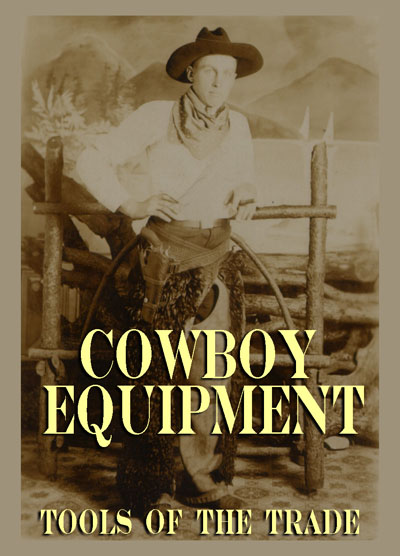
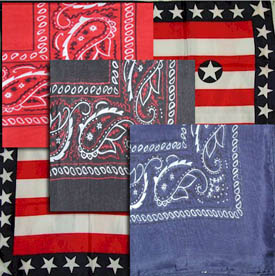

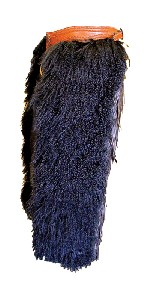
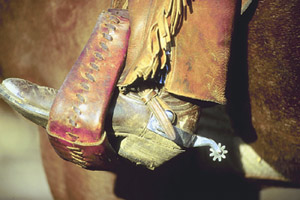 riders and would-be riders now were never worn by the cow-hands of the old west. They wore boots that stopped just short of the knee, for the low cut boots, no matter how handsome, collected sand and gravel when scuffing around in a dusty corral, roping stock from the ground, or working around a branding fire.
riders and would-be riders now were never worn by the cow-hands of the old west. They wore boots that stopped just short of the knee, for the low cut boots, no matter how handsome, collected sand and gravel when scuffing around in a dusty corral, roping stock from the ground, or working around a branding fire.
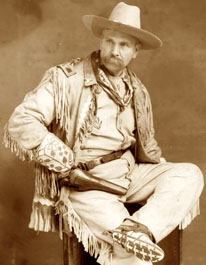

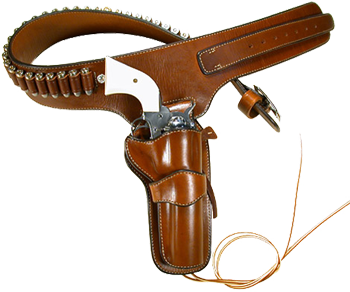 Not long ago an article was written where someone
inferred that the average rider's pistol was usually rusty and in poor shape. This was simply not the case. A pistol cost a rider a month's salary, and it was usually the best cared for piece of equipment he owned.
Not long ago an article was written where someone
inferred that the average rider's pistol was usually rusty and in poor shape. This was simply not the case. A pistol cost a rider a month's salary, and it was usually the best cared for piece of equipment he owned.
